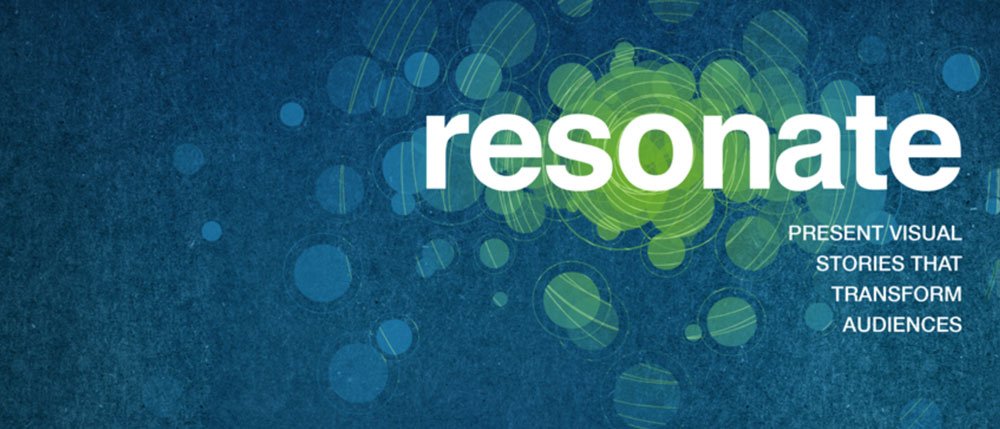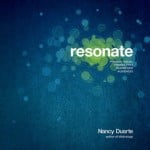How to Present Visual Stories that Transform Audiences


It has been said that there are no new stories; there are only new ways of telling the old stories. The same holds true for public speaking and presentation skills. After all, people have been writing about public speaking since Aristotle wrote Rhetoric more than 2,300 years ago; including all of us here at Presentation Guru!
But every now and then, a book comes along that presents the same information in a creative and compelling format. It prompts us to look at an old subject in a new way. It “resonates” with us. Nancy Duarte’s resonate: Present Visual Stories that Transform Audiences is one of those books.


The book’s tagline, “Present Visual Stories that Transform Audiences”, gives a clue to two themes that Duarte emphasizes throughout the book: (1) stories convey meaning; and (2) the audience is the hero. These are fundamental principles for anyone who wants to be a better public speaker.
The book is divided into nine chapters as follows:
1) Why Resonate?
The opening chapter sets the stage for the rest of the book. It introduces some important ideas on which Duarte elaborates in subsequent chapters. Most importantly, it gets us to think about why we are presenting in the first place, and gets us excited about the process.
Key Message: Resonance causes change.
2) Lessons from Myths and Movies
Drawing on lessons from the dramatic arts, Duarte explains why stories are important for presentations. As she says, we need to shift our mindset from solely transferring information to creating an experience. We should take the audience on a journey from what is to what could be.
Study after study has shown that our brains are wired for stories. Stories add meaning. Duarte examines the structure of stories, including one of the most important, The Hero’s Journey.
Key Message: Incorporating story into presentations has an exponential effect on outcomes.
3) Get to Know the Hero
The hero, of course, is the audience. A speech or presentation is always about the audience. We need to understand the people to whom we will speak and communicate from the common ground that we share. We can connect with our audience through shared experiences, common goals and our qualifications.
Key Message: If a presenter knows the audience’s resonant frequency and tunes to that, the audience will move.
4) Define the Journey
Be clear about your “big idea”, the one key message that you want to convey. Once you have your big idea, plan how you will lead the audience to it. A good presentation moves an audience beyond its comfort zone. In so doing, however, you will often encounter resistance. Acknowledge and respect the resistance, but show your audience that they are in good hands and that the reward is worth the risk. This chapter provides some good insights into overcoming that resistance.
Key Message: Every audience will persist in a state of rest unless compelled to change.
5) Create Meaningful Content
One of the things that I like best about this chapter is its positioning in the book. It is only at the halfway point — after we have given sufficient thought to why we are speaking, who our audience is and what our key message is. Only then should we turn to the content. When creating content, we should generate as many ideas as possible and then transform those ideas into messages. We also have to balance logos, ethos and pathos, Aristotle’s three pillars of rhetoric.
Key Message: Use the big idea to filter out all frequencies other than the resonant frequency.
6) Structure Reveals Insights
A solid structure is the foundation of a coherent presentation. Duarte encourages us to move away from a linear format when designing a presentation (e.g., a series of slides) and create an environment where we can see the presentation spatially (e.g., sticky note, whiteboard, etc.). She explains how to order our messages for maximum impact and how to create emotional contrast in our presentations.
Key Message: Structure is greater than the sum of its parts.
7) Deliver Something They’ll Always Remember
We are encouraged to create a moment in each presentation that is so profound that the audience will not forget it. Duarte calls this a S.T.A.R. Moment (Something They’ll Always Remember) and looks at five ways in which to create one: memorable dramatization; repeatable sound bites; evocative visuals; emotive storytelling; and shocking statistics. If you are looking for “sticky” moments in your speeches and presentations, you will also find Made to Stick by Chip and Dan Heath helpful.
Key Message: Memorable moments are repeated and retransmitted so they cover longer distances.
8) There’s Always Room to Improve
In this chapter, Duarte discusses how to amplify the message and minimize the noise (bias, credibility, semantics and experience). She discusses giving a positive first impression, being succinct, weaning ourselves from slides and balancing logic with emotion. I also appreciated her admonition against using jargon and her encouragement of being as brief as possible.
Key Message: Audience interest is directly proportionate to the presenter’s preparation.
9) Change Your World
Ending on an inspirational note, Duarte uses a quotation that is often attributed to John F. Kennedy:
“The only reason to give a speech is to change the world.”
Whenever we give a speech or presentation, it is like casting a pebble into a still lake or pond. We have no idea just how far the ripples will spread. All change, whether it is worldwide or in our corporate department, begins with an idea. In order for that idea to take root, it has to be shared with others.
Key Message: You can change the world.
To support her points, Duarte examines in detail a wide variety of speeches and speakers. She shares several of her own experiences, and even goes beyond the public speaking realm to find insights for speakers from the worlds of dance, music, film and poetry. She also uses an interesting technique known as a “sparkline” to analyze several speeches graphically.
As beautiful as this book is, it would be a mistake to keep it in pristine condition. resonate should be read with a pencil and a highlighter in hand. It should be annotated and marked up and tagged and eventually become dog-eared from use. It deserves a place on your bookshelf next to other key public speaking reference books. You can buy your copy of the book here.













